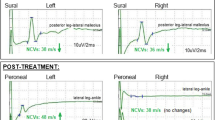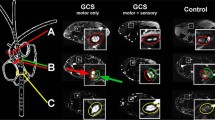Abstract
Introduction
We investigated whether MR diffusion tensor imaging (DTI) analysis of the cervical spinal cord could aid the (differential) diagnosis of sensory neuronopathies, an underdiagnosed group of diseases of the peripheral nervous system.
Methods
We obtained spinal cord DTI and T2WI at 3 T from 28 patients, 14 diabetic subjects with sensory-motor distal polyneuropathy, and 20 healthy controls. We quantified DTI-based parameters and looked at the hyperintense T2W signal at the spinal cord posterior columns. Fractional anisotropy and mean diffusivity values at C2–C3 and C3–C4 levels were compared between groups. We also compared average fractional anisotropy (mean of values at C2–C3 and C3–C4 levels). A receiver operating characteristic (ROC) curve was used to determine diagnostic accuracy of average fractional anisotropy, and we compared its sensitivity against the hyperintense signal in segregating patients from the other subjects.
Results
Mean age and disease duration were 52 ± 10 and 11.4 ± 9.3 years in the patient group. Eighteen subjects had idiopathic disease and 6 dysimmune etiology. Fractional anisotropy at C3–C4 level and average fractional anisotropy were significantly different between patients and healthy controls (p < 0.001 and <0.001) and between patients and diabetic subjects (p = 0.019 and 0.027). Average fractional anisotropy presented an area under the curve of 0.838. Moreover, it had higher sensitivity than visual detection of the hyperintense signal (0.86 vs. 0.54), particularly for patients with short disease duration.
Conclusion
DTI-based analysis enables in vivo detection of posterior column damage in sensory neuronopathy patients and is a useful diagnostic test for this condition. It also helps the differential diagnosis between sensory neuronopathy and distal polyneuropathies.


Similar content being viewed by others
References
Camdessanché J-P, Jousserand G, Ferraud K et al (2009) The pattern and diagnostic criteria of sensory neuronopathy: a case–control study. Brain 132:1723–1733. doi:10.1093/brain/awp136
Bao Y-F, Tang W-J, Zhu D-Q et al (2013) Sensory neuronopathy involves the spinal cord and brachial plexus: a quantitative study employing multiple-echo data image combination (MEDIC) and turbo inversion recovery magnitude (TIRM). Neuroradiology 55:41–48. doi:10.1007/s00234-012-1085-x
Casseb RF, Martinez ARM, de Paiva JLR, França MC Neuroimaging in sensory neuronopathy. J Neuroimaging 25:704–9. doi:10.1111/jon.12210
Paiva JLR de, Casseb RF, Martinez ARM et al (2015) Diffusion tensor imaging (DTI) of the cervical cord in sensory neuronopathies (P5.070). Neurology 84, P5.070
Alexander AL, Hurley SA, Samsonov AA et al (2011) Characterization of cerebral white matter properties using quantitative magnetic resonance imaging stains. Brain Connect 1:423–446. doi:10.1089/brain.2011.0071
Kearney H, Miller DH, Ciccarelli O (2015) Spinal cord MRI in multiple sclerosis—diagnostic, prognostic and clinical value. Nat Rev Neurol 11:327–338. doi:10.1038/nrneurol.2015.80
El Mendili M-M, Cohen-Adad J, Pelegrini-Issac M et al (2014) Multi-parametric spinal cord MRI as potential progression marker in amyotrophic lateral sclerosis. PLoS ONE 9:e95516. doi:10.1371/journal.pone.0095516
Garcia RU, Ricardo JAG, Horta CA et al (2013) Ulnar sensory-motor amplitude ratio: a new tool to differentiate ganglionopathy from polyneuropathy. Arq Neuropsiquiatr 71:465–469. doi:10.1590/0004-282X20130063
Merkies IS, Schmitz PI, van der Meché FG, van Doorn PA (2000) Psychometric evaluation of a new sensory scale in immune-mediated polyneuropathies. Inflammatory Neuropathy Cause and Treatment (INCAT) Group. Neurology 54:943–949
Bennett M (2001) The LANSS pain scale: the Leeds assessment of neuropathic symptoms and signs. Pain 92:147–157. doi:10.1016/S0304-3959(00)00482-6
Schmitz-Hübsch T, du Montcel ST, Baliko L et al (2006) Scale for the assessment and rating of ataxia: development of a new clinical scale. Neurology 66:1717–1720. doi:10.1212/01.wnl.0000219042.60538.92
Okumura R, Asato R, Shimada T et al Degeneration of the posterior columns of the spinal cord: postmortem MRI and histopathology. J Comput Assist Tomogr 16:865–7
Acknowledgments
We thank Brunno Machado de Campos, Benílton de Sá Carvalho and biomedical technicians for their help in MRI discussions, statistical analysis and data acquisition, respectively. We thank FAPESP (Sao Paulo Research Foundation - Grants 2013/01766-7, 2013/07559-3 – Brazilian governmental agency) for financial support.
Author information
Authors and Affiliations
Corresponding author
Ethics declarations
We declare that all human studies have been approved by the research ethics committee of the School of Medical Sciences - UNICAMP and have therefore been performed in accordance with the ethical standards laid down in the 1964 Declaration of Helsinki and its later amendments. We declare that all patients gave informed consent prior to inclusion in this study.
Conflict of interest
We declare that we have no conflict of interest.
Rights and permissions
About this article
Cite this article
Casseb, R.F., de Paiva, J.L.R., Branco, L.M.T. et al. Spinal cord diffusion tensor imaging in patients with sensory neuronopathy. Neuroradiology 58, 1103–1108 (2016). https://doi.org/10.1007/s00234-016-1738-2
Received:
Accepted:
Published:
Issue Date:
DOI: https://doi.org/10.1007/s00234-016-1738-2




